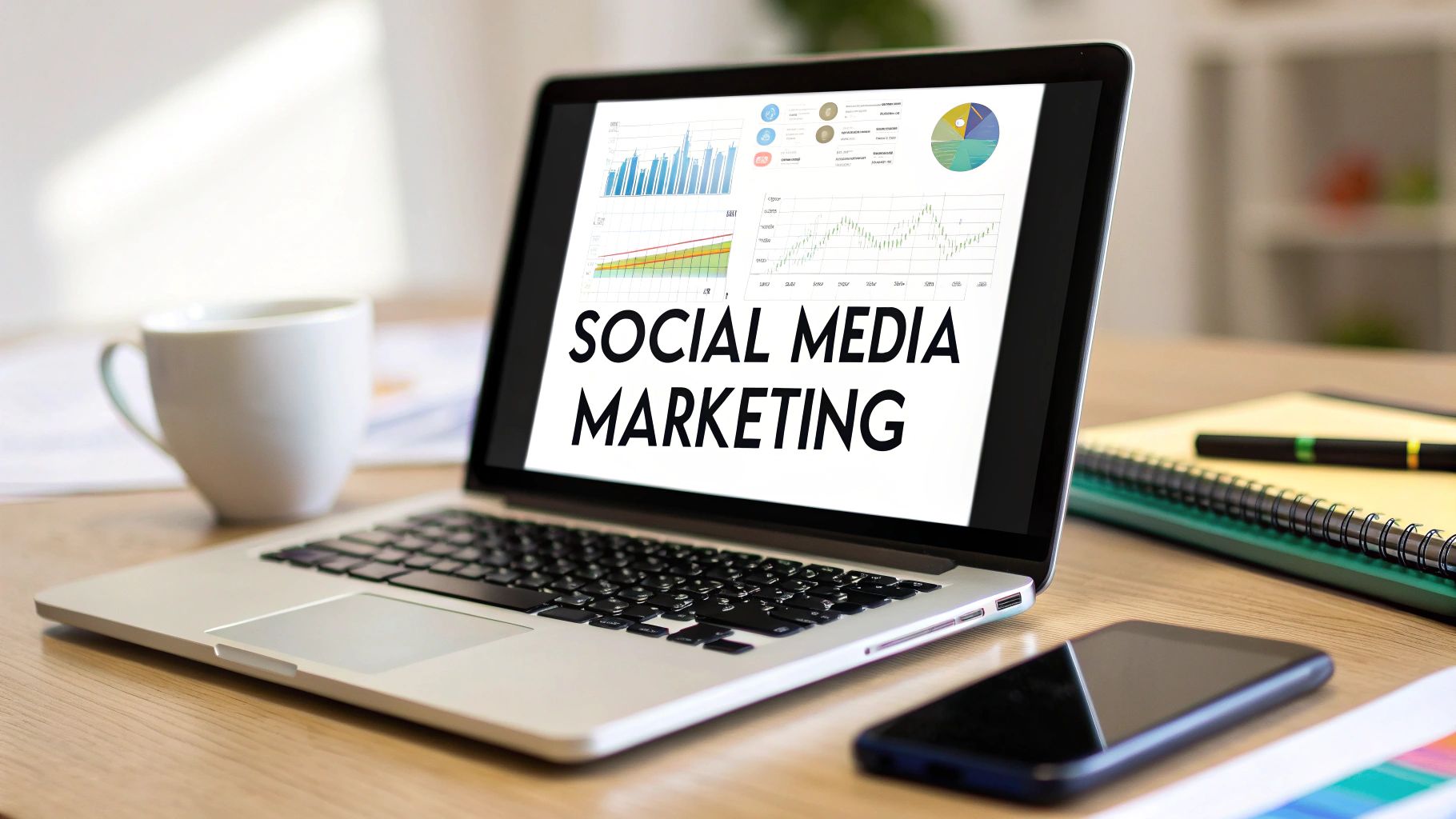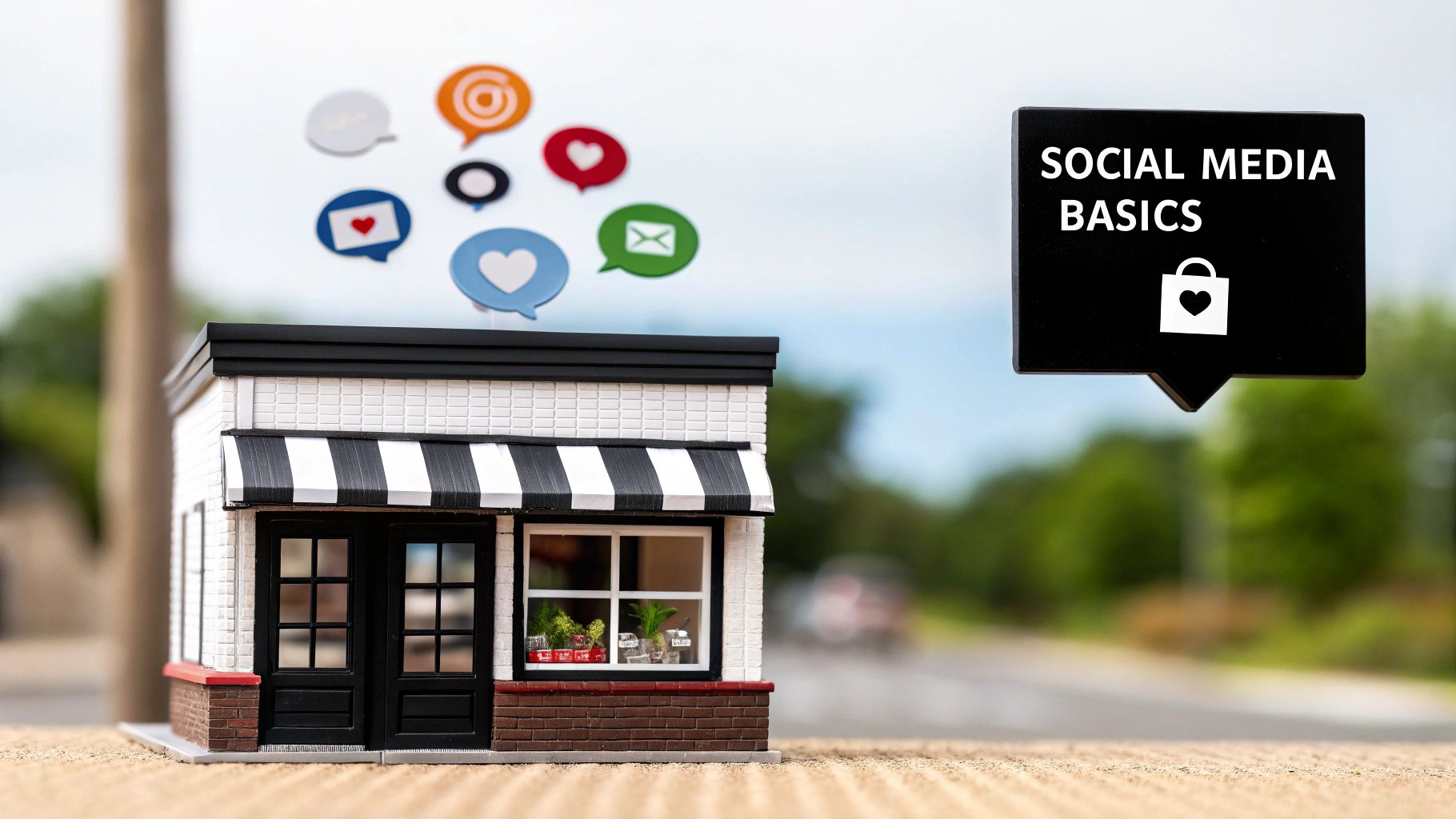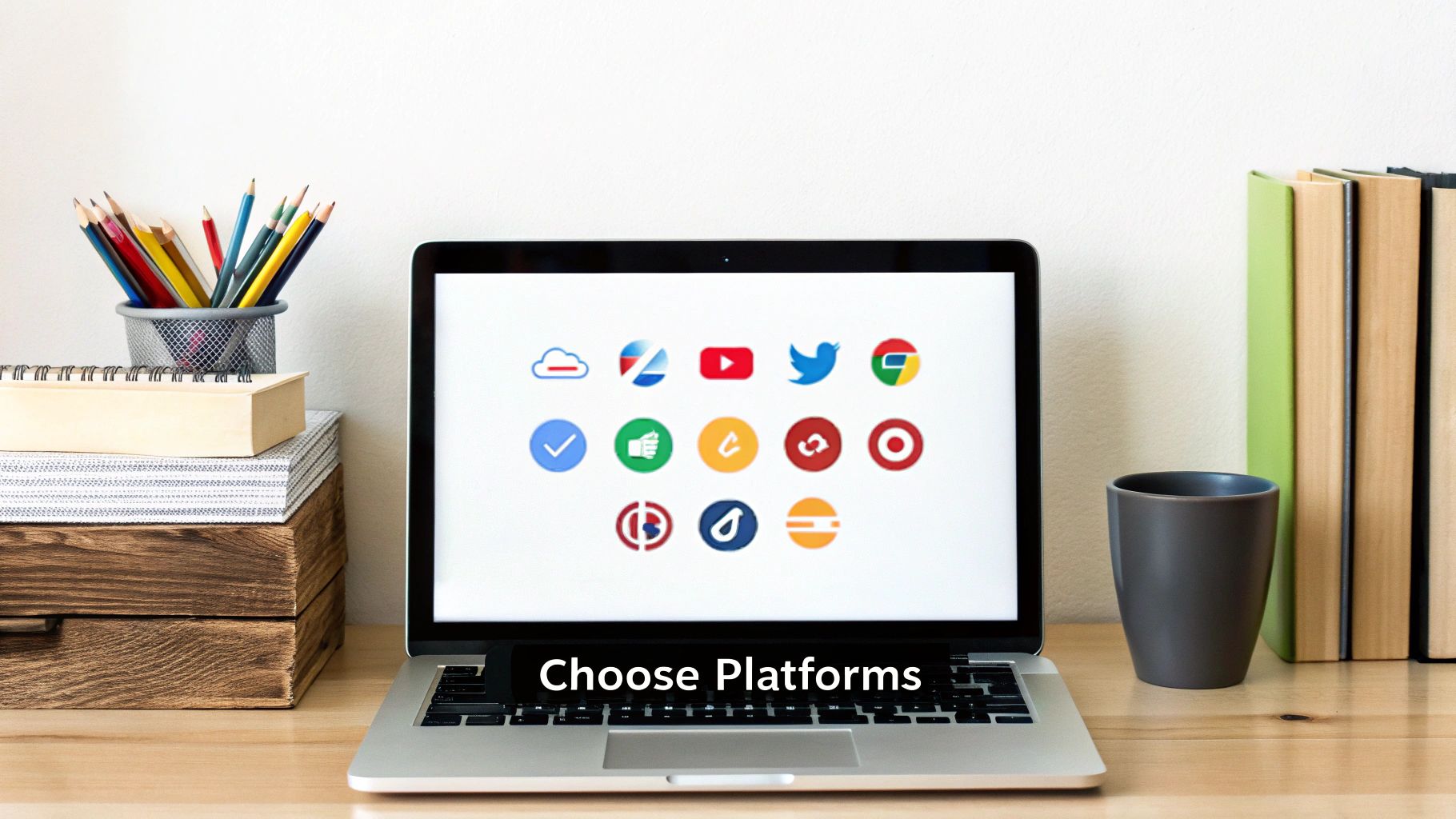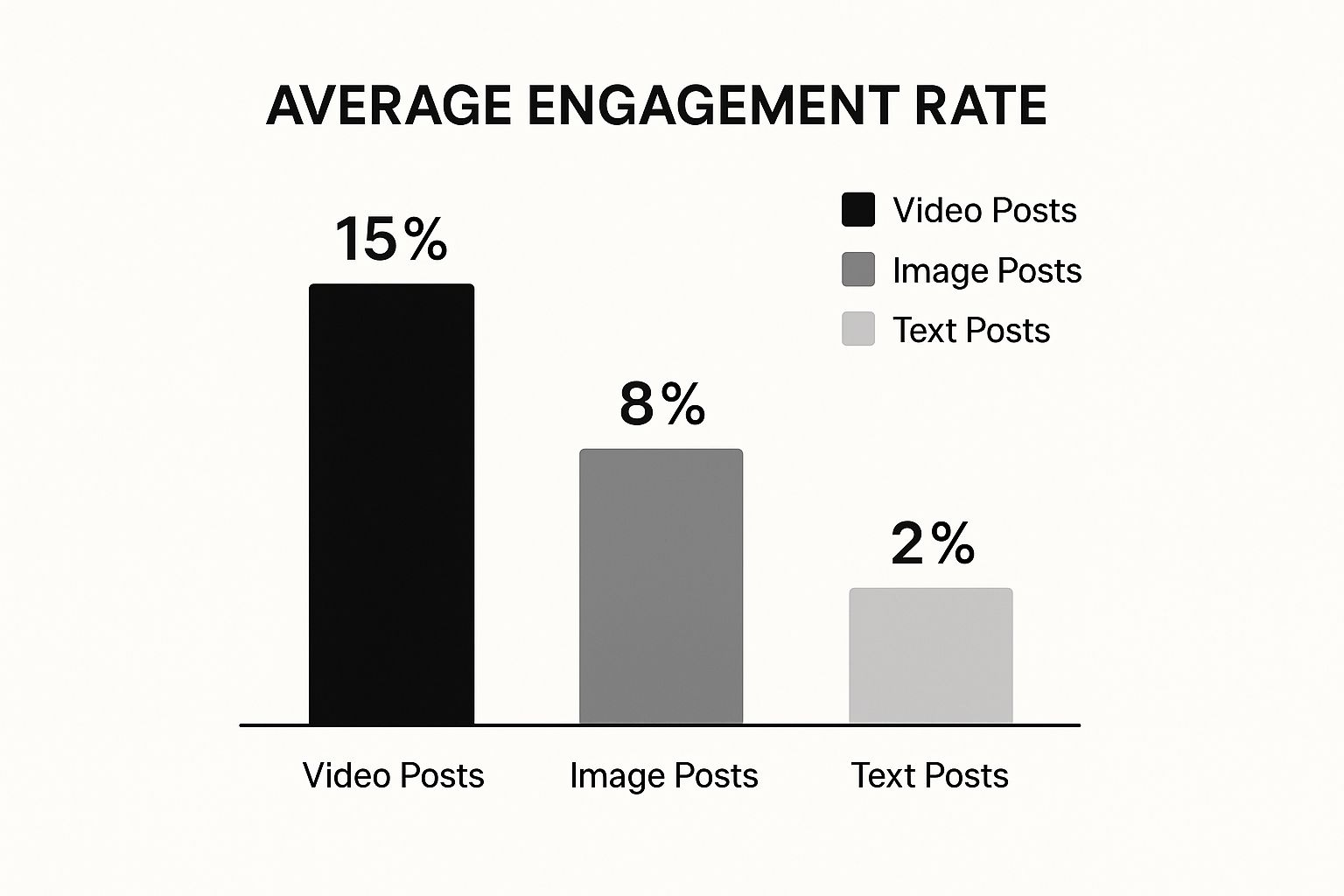
Social Media Marketing for Small Business
Published on 2025-09-29
For any small business owner, thinking about social media can feel overwhelming. But here’s the reality: it's no longer just an "extra" marketing task. It's your new Main Street storefront, the place where you meet your customers, build your reputation, and ultimately, grow your business without needing a massive budget.
This guide will walk you through a complete roadmap for planning and supercharging your social media from the ground up.
Why Social Media Is Your New Main Street
Let's get real for a moment. For a small business, social media isn't just another channel—it's the digital town square where your ideal customers are already spending their time. Platforms like Instagram, TikTok, and Facebook have become the go-to spots for people to find new brands and products. This shift away from traditional search engines is a huge opportunity for you.
You can now connect directly with your community, build genuine trust, and even go toe-to-toe with the big guys. You don't need a huge marketing department or a bottomless budget. What you need is authentic storytelling and real engagement. Those are your new secret weapons.
The Big Shift to Social Discovery
The way people shop has completely changed. Instead of just typing what they want into Google, they're discovering products through an influencer's video, a targeted ad in their feed, or a post from a friend. In fact, a whopping 58% of consumers now find new businesses through social media—that’s more than traditional search.
This is why having a solid social media game plan is non-negotiable.
- It builds real connections. Sharing a behind-the-scenes look at your process or featuring a customer's story creates a human touch that big corporations can't fake.
- It gets the right eyes on your brand. You can target ads and content to specific people, making every dollar you spend work harder.
- It creates a loyal community. Social media is a conversation. You get instant feedback and can build a group of fans who will cheer you on.
Success here means acting like a member of the community, not just a business trying to sell something. A strong online presence is the foundation for everything that follows. If you're starting from scratch, learning how to build an online presence is your first move: https://autoghostwriter.com/blog/how-to-build-online-presence
Seeing the Social Landscape Clearly
Before you jump in, it helps to know where your customers are. The data below breaks down which age groups are hanging out on which platforms. This is your cheat sheet for deciding where to focus your efforts.

As you can see, Instagram and TikTok are huge with younger crowds, while Facebook still has a massive reach across almost every age group. Knowing this helps you make smart choices. For example, if you sell handcrafted jewelry or unique home decor, a platform like Pinterest could be a goldmine. Diving into a comprehensive guide to using Pinterest for business could unlock a whole new audience you hadn't considered.
Your goal isn't to be everywhere. It's to be where it counts—where your ideal customers are. Pick one or two platforms, get really good at them, and then think about expanding.
Key Social Media Opportunities for Small Businesses
To put it all together, social media offers some incredible, tangible benefits for small businesses that were once out of reach. Here's a quick look at the biggest opportunities waiting for you.
| Opportunity | Why It Matters | Example Platform |
|---|---|---|
| Direct Customer Engagement | Build relationships and get real-time feedback without a middleman. | Instagram DMs, Facebook comments |
| Hyper-Targeted Advertising | Reach specific demographics, interests, and locations on a small budget. | Facebook Ads, TikTok Ads |
| Community Building | Create a loyal following of brand advocates who spread the word for you. | Facebook Groups, Discord |
| Visual Storytelling | Showcase your products and brand personality in a compelling, human way. | Instagram Reels, Pinterest Pins |
Tapping into these areas allows you to connect with customers, drive targeted traffic, and build a brand that people genuinely care about.
Setting Goals That Actually Drive Business Growth

Let’s be honest. Posting on social media just for the sake of it is a huge waste of time. It feels productive, but without a clear destination in mind, you're just spinning your wheels. Before you even think about your next post, we need to nail down what success actually looks like for your business.
This is the bedrock of any social media plan that gets real results. Forget about chasing vanity metrics like follower counts for a minute. A big audience is great, but it's completely useless if none of those people are interested in what you sell.
We need to shift the focus from "getting more likes" to goals that actually move the needle—like "generating more qualified leads" or "increasing online sales." Giving every post a specific job to do is how you turn your social channels into a genuine business asset.
Moving Beyond Vanity Metrics
It's so easy to get caught up in the numbers staring back at you from the screen. Likes and new followers provide a nice little dopamine hit, but they don't pay the bills. The real wins come from goals tied directly to your business's health and bottom line.
So, what should you be tracking instead? Think about what would make a tangible difference for your business this quarter.
- Lead Generation: Maybe you want to get five new qualified leads a week from your Instagram DMs.
- Website Traffic: What if you aimed to boost traffic from your Facebook page to your product pages by 20%?
- Sales Conversion: How about a goal to increase online sales from social media by 15%?
- Brand Awareness: Or perhaps you want to get 25% more mentions from local accounts to build a stronger community presence.
These are the kind of goals you can actually measure. They give you a clear benchmark to see if what you're doing is working, or if it's time to change things up.
Key Takeaway: Your social media goals should mirror your business goals. If you need to increase revenue, your number one social media metric should be sales conversions, not just your engagement rate.
Building Your Ideal Customer Persona
Once you know what you want to achieve, you have to get crystal clear on who you're trying to reach. You can't create content that resonates if you don't know who you're talking to. That’s where building an ideal customer persona comes in.
A persona is basically a detailed sketch of your perfect customer. It’s more than just basic demographics; it digs into their motivations, their daily struggles, and their online habits. Think of it like creating a character profile for the person who is most likely to fall in love with your business.
Questions to Build Your Persona
To bring this person to life, you need to ask the right questions. And don't just guess! Dig into the data you already have from current customers, your website analytics, and your social media insights.
Who are they?
- What's their age, location, and job title?
- What does a typical day look like for them?
What are their challenges?
- What problems keep them up at night that your business can solve?
- For example, a local coffee shop's ideal customer might be a remote worker who's desperate for a quiet, inspiring place to work that isn't their own living room.
Where do they hang out online?
- Which social media apps do they actually use? Are they scrolling Instagram Reels for fun or are they on LinkedIn to network?
- What influencers, blogs, or online groups do they follow and trust?
Knowing these details is a game-changer. It informs your tone of voice, the kind of content you create, and even the platforms you decide to focus on. When you speak directly to someone's specific needs, they feel seen—and they're far more likely to listen, engage, and become a customer for life.
Choosing Your Platforms and Creating Content That Connects
Trying to be everywhere at once on social media is a classic rookie mistake. It's a surefire path to burnout, and frankly, it just doesn't work. The smartest social media marketing for a small business isn't about mastering every single platform; it's about going all-in on the one or two channels where your ideal customers actually hang out.
This focused approach saves you a ton of time and energy, and it makes sure your message is actually heard by the right people.
Think of it this way: a B2B consultant trying to find clients on TikTok is like a baker setting up a cake stand in a library. Sure, you might get a few curious looks, but you're not going to find your audience. The real magic happens when you match the platform's vibe and user base to what your business is all about.
Finding Your Digital Home Base
So, where do you start? Your customer persona is your compass. Where do these people go for inspiration, information, or just to unwind?
Let’s look at a couple of real-world examples.
A local bakery that specializes in custom wedding cakes would be a natural fit for Instagram and Pinterest. These are highly visual platforms where people are actively looking for aesthetic ideas and inspiration. High-quality photos of those stunning cake designs and behind-the-scenes videos of the decorating process would absolutely kill it there.
On the other hand, a B2B tech consultant targeting startup founders would be wasting their time on Pinterest. Their audience lives on LinkedIn. Here, the content shifts from pretty pictures to professional value—sharing sharp articles on industry trends, posting case studies of client wins, and starting conversations that show off their expertise.
Choosing the right platform is the single most important decision you'll make in your social media strategy. It's better to create amazing content for one highly relevant platform than to spread mediocre content across five irrelevant ones.
To help you decide, here's a quick breakdown of the major players.
Which Social Media Platform Is Best for Your Business?
Finding the right fit depends entirely on your industry and who you're trying to reach. This table should help you narrow down the best starting point for your business.
| Platform | Best For | Key Content Format | Audience Demographic |
|---|---|---|---|
| Community building, local businesses, broad audience reach | Videos, images, community posts, ads | Broad; strong in the 35+ age range | |
| Visual brands (e.g., fashion, food, travel, e-commerce) | Reels, Stories, high-quality photos, carousels | Primarily 18-34, slightly female-skewing | |
| B2B networking, professional services, thought leadership | Articles, text posts, professional videos | Professionals, B2B decision-makers, job seekers | |
| TikTok | Trend-driven content, reaching a younger audience | Short-form vertical videos | Heavily skewed towards Gen Z (under 25) |
| Driving traffic, visual discovery (e.g., DIY, recipes, design) | Infographics, shoppable pins, high-quality images | Primarily female, strong in the 25-45 range | |
| X (Twitter) | Real-time news, customer service, brand voice | Short text posts, memes, quick video clips | Well-informed users, journalists, tech industry |
Remember, this is just a starting point. The best way to know for sure is to test and see where you get the most traction with your specific audience.
Developing Your Content Pillars
Once you’ve picked your platform, you need a game plan for what to post. This is where content pillars come in. Think of these as three to five core themes your brand will talk about over and over again. They give you structure and make sure everything you post is on-brand and relevant to your audience.
Let's go back to our bakery. Their content pillars could be:
- Product Showcase: Gorgeous shots of finished cakes and seasonal treats.
- Behind the Scenes: Videos of the team, the decorating process, and where they get their ingredients.
- Customer Stories: Featuring photos of happy couples with their wedding cake.
- Baking Tips: Sharing simple tricks for home bakers to build a community and establish authority.
Having a framework like this makes content creation so much easier. Instead of staring at a blank screen wondering what to post, you just rotate through your pillars. It's a key piece of successful social media content planning.
The Undeniable Power of Video
No matter which platform you choose, video is no longer a "nice to have"—it's a must. With an estimated 5.42 billion social media users scrolling through their feeds, you have to find a way to stand out. Video does that. In fact, studies show that 78% of people would rather learn about a new product by watching a short video.
This chart paints a pretty clear picture of how different content formats stack up.

The data doesn't lie. Video drives way more engagement than static images or text alone, making it an incredibly powerful tool for any small business.
And you don't need a fancy film crew! Your smartphone is more than enough to get started. In fact, authentic, unpolished videos often do better because they feel more real. A quick tour of your workshop, a time-lapse of you packing an order, or a simple video answering a customer question can build a surprisingly strong connection.
Crafting a Simple Content Calendar
A content calendar sounds intimidating, but it doesn't have to be. A simple spreadsheet is all you really need to get organized and stay consistent. Planning ahead saves you from the last-minute scramble of figuring out what to post.
For each post, your calendar should track a few key things:
- Date and Time: When it's scheduled to go live.
- Platform: Which social channel it's for.
- Content Pillar: The core theme it ties back to.
- Format: Is it a Reel, a carousel, a story, or a static image?
- Caption and Hashtags: The copy that goes with your visual.
- Status: Is it just an idea, in progress, or already published?
Consistency is what fuels social media growth, and a simple calendar is the map that keeps you on the right road. To really streamline your workflow, you might want to explore the best social media marketing tools out there that can help with scheduling, analytics, and more.
Turning Followers Into a Loyal Community
Having a social media page is just the start. The real magic happens when you turn that follower count into a tight-knit community that actually cares about your brand. Think of your social media not as a billboard, but as your local block party. It's about conversations, not just announcements.
The goal here is to build genuine relationships that feel more personal than a simple sale. You're creating a space where your customers feel like they're part of something—a place where they're heard and valued. That’s how you get brand advocates who not only buy from you repeatedly but also rave about you to their friends.

Spark Real Conversations
Engagement isn't just about racking up likes. It's about starting actual conversations. When someone takes a minute out of their day to comment on your post, treat it like gold. A generic "Thanks!" is fine, but a personal, thoughtful response is so much better.
Try asking open-ended questions in your captions. Instead of just posting a picture of your new product, ask your audience how they’d use it or what color they'd love to see it in. This tiny shift changes a one-way post into a two-way conversation.
- Ask for opinions. "We're thinking of bringing back a classic flavor. Should it be A or B? Let us know in the comments!"
- Respond with personality. Ditch the corporate-speak. If your brand is fun, be fun in your replies! Show there's a real human behind the screen.
- Tag people in your responses. This sends them a direct notification and makes the exchange feel much more personal.
This is how you show your audience that you’re listening and that you genuinely care about what they have to say.
Celebrate Your Customers with User-Generated Content
One of the best ways to build a community is by showcasing user-generated content (UGC). This is any photo, video, or review created by your customers that features your brand. Sharing UGC is a huge win-win. You get authentic, relatable content for your feed, and your customers get a moment in the spotlight.
When you feature a customer's post, you're giving them a public shout-out and showing everyone else how much you appreciate your community. It often inspires others to share their own photos, creating this awesome cycle of engagement and social proof.
Imagine a local coffee shop creating a hashtag like #MyMorningMug and asking customers to share their coffee moments. They could feature the best photo each week and maybe give the winner a free latte. It’s a simple idea, but it turns passive followers into active participants in your story.
Don't just reshare their content—celebrate it. Add a caption explaining why you loved their post and express your gratitude. That small bit of extra effort goes a long way in building loyalty.
Connect with Your Local Community
For most small businesses, your biggest fans are right in your own backyard. Getting involved in your local community is a fantastic way to build goodwill and strengthen those ties, both online and in real life.
This could mean teaming up with another local shop for a giveaway or sponsoring the neighborhood little league team. Whatever you do, share it on social media! It shows your followers that you’re truly invested in the place you all call home.
People expect this now more than ever. Data shows that by 2025, 63% of consumers want to see businesses support local events, and 55% love seeing collaborations between small businesses. Getting involved locally isn't just a nice thing to do; it’s what your customers are looking for. For a deeper dive, you can explore more small business marketing statistics.
By having real conversations, celebrating your customers, and investing in your local area, you transform your social media from just another marketing channel into the digital heart of your community.
Tracking Your Results to Refine Your Strategy
So, you're creating great content and getting it out there. But how do you know if any of it is actually working? This is where a lot of small business owners get stuck, but it's the part that separates guessing from growing.
Diving into your analytics isn't about getting lost in a sea of confusing numbers. Think of it as a direct feedback loop from your audience. The data tells you exactly what’s hitting the mark and what’s completely missing it. This insight is gold because it allows you to stop throwing spaghetti at the wall and start making strategic moves that actually pay off.
Focusing on Metrics That Matter
It's tempting to get a thrill from watching your follower count go up. We all do it. But those are often just vanity metrics—they look good on the surface but don't necessarily translate to more customers or sales.
The real trick is to focus on the numbers that connect directly back to the goals you set in the beginning.
- Goal: Brand Awareness? Keep an eye on reach (the number of unique people who see your posts) and impressions (the total times your content was shown). This tells you how wide your net is being cast.
- Goal: Website Traffic? Your north star is the click-through rate (CTR). It’s the clearest indicator of how many people saw your post and were compelled enough to click the link.
- Goal: More Sales? You need to be tracking your conversion rate. This is the percentage of people who clicked your link and then completed a specific action, like buying a product or signing up for your newsletter.
- Goal: Community Engagement? Look beyond likes. Focus on comments, shares, and saves. These actions take more effort and are a huge sign that you’re building a real connection with people.
Using Built-In Analytics Tools
You don't need to spend a dime on fancy software to get started. Every major platform has its own powerful, free analytics tools. Instagram Insights and Facebook's Meta Business Suite are surprisingly robust and give you everything you need.
Take a look at your Instagram posts, for example. You can see a full breakdown of how many accounts you reached and, more importantly, how they found you—was it through a hashtag, from their home feed, or by visiting your profile? This helps you figure out which content formats and topics are giving you the most visibility.
Your analytics dashboard is your customer feedback loop. It tells you exactly what your audience wants to see more of. Ignoring it is like ignoring a line of customers trying to give you suggestions.
Establishing a Simple Review Routine
The key to not getting overwhelmed is to build a simple, repeatable review process. I recommend setting aside a little time once a month to check in on your performance. It's enough to spot trends without getting bogged down in daily fluctuations.
Here’s a quick framework for a monthly review:
- Pull up your top-performing posts. What were your 3-5 biggest hits last month? Look for a common thread. Was it a specific type of video? A question you asked? The time of day you posted?
- Find the duds. Look at the posts that fell flat. Don't get discouraged—this is just as valuable. It’s the data telling you what your audience doesn't care about.
- Check your audience demographics. Are the people following you the same people you’re trying to reach? The analytics will show you their age, gender, and location.
- Analyze your website clicks. If traffic is a goal, which posts actually got people to leave the app and visit your site? This shows you what kind of messaging drives action.
This simple process turns all that raw data into a clear action plan. You’ll know what to double down on and what to stop wasting your time on. Understanding how to measure social media ROI is what gives you the confidence to invest your time and resources effectively. For a deeper dive, check out our guide on how to measure social media ROI.
Answering Your Top Social Media Marketing Questions
Getting started with social media for your business can feel a little overwhelming. You know you need to be there, but it's natural to have questions pop up as you go. Let’s clear up some of the most common hurdles small business owners face.
Think of this as your practical, no-fluff FAQ. It's designed to help you make smart decisions with your time and money right from the get-go.
How Much Should I Actually Budget for Social Media?
There’s no magic number here, but a good starting point is to set aside 5-15% of your total marketing budget for social media. If you're just dipping your toes in, don't feel like you have to go big. Even a small ad spend, say $10-$20 a day on your main platform, can give you a ton of valuable data.
The trick is to start small, watch your return on investment (ROI) like a hawk, and then pour what you earn back into the campaigns that are clearly working. Just remember, your budget isn't only for ads. It also needs to cover any helpful tools you might use, like a scheduling app or design software.
My Two Cents: Don't just set your budget and forget it. Look at your spending every single month. If you see that one type of ad is bringing in paying customers while another is falling flat, be ready to shift your money. Flexibility is key—let the data tell you where to spend.
How Often Should I Be Posting?
This is the classic question, isn't it? But the answer is simpler than you think: consistency and quality will always beat frequency. Seriously. It's way better to share three high-value posts a week that your audience actually enjoys than ten mediocre ones they just scroll past.
A decent benchmark to aim for is 3-5 times a week on platforms like Instagram and Facebook. But honestly, the real answer is hiding in your analytics.
Your audience will show you what they want if you pay attention. Look for these signals:
- Engagement Spikes: Check your platform's built-in analytics. When are your posts getting the most comments and shares?
- Content That Clicks: Are short videos getting double the love compared to static photos? That’s your cue to make more videos.
- Audience Activity: Most platforms tell you exactly when your followers are most active. That’s your golden window to post.
Bottom line: tailor your schedule to your audience's behavior, not some generic rule you read online.
Can I Handle Social Media Myself, or Do I Need to Hire Help?
You can absolutely manage this yourself, especially in the beginning. In fact, I'd say you should. It’s the best way to get a direct, unfiltered connection with your customers. You'll learn what they care about, the questions they ask, and the exact language they use.
Start by carving out a few focused hours each week to plan and create your content. A great time-saving trick is to "batch" your work—for example, shoot all your photos on a Monday and write all your captions on a Tuesday. It makes the whole process feel much more manageable.
You should only start thinking about hiring a freelance social media manager or an agency when you hit a specific tipping point. That moment comes when you feel that the time you spend on social media is actively stopping you from focusing on growing your business. Once it feels like a chore that's holding you back, that's your signal to start delegating.
What Are the Common Mistakes I Should Avoid?
So many businesses fall into the same traps when they start out. Just by avoiding these common blunders, you’ll be way ahead of the game and save yourself a lot of frustration.
The single biggest mistake is treating social media like a billboard instead of a conversation. If all you do is post sales pitches, people will tune you out fast. They follow you for connection and value, not just ads.
Here are a few other pitfalls to watch out for:
- Posting on a Whim: Don't just post because you feel you have to. Every single piece of content should have a purpose that connects back to your business goals.
- Spreading Yourself Too Thin: It’s so tempting to jump on every new platform. Don't. Get really good at the one or two channels where your customers actually hang out before you even think about expanding.
- Ignoring Your Community: Engagement is a gift. When someone takes the time to comment or send you a message, always respond. Ghosting your community is the quickest way to lose it.
- Buying Fake Followers: It might seem like a shortcut to looking legit, but it's a complete waste of money. Fake followers kill your engagement rate, provide zero business value, and can wreck your credibility if you get caught.
Focus on real growth and genuine conversations. That’s how you build a social media presence that actually helps your business thrive.
Ready to create compelling LinkedIn content that drives real engagement without spending hours a week? With autoghostwriter, you can use advanced AI to generate authentic, high-quality posts that capture attention and build your professional network.
Start creating scroll-stopping content with autoghostwriter today!